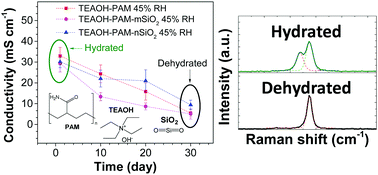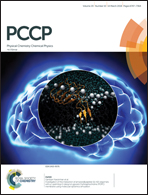The effect of SiO2 additives on solid hydroxide ion-conducting polymer electrolytes: a Raman microscopy study†
Abstract
The effect of SiO2 additives on the conductivity and longevity of an alkaline tetraethylammonium hydroxide (TEAOH)–poly(acrylamide) (PAM) polymer electrolyte was investigated. Electrochemical impedance spectroscopy (EIS) and Raman microscopy studies were performed for TEAOH–PAM with micro-sized (mSiO2) or nano-sized (nSiO2) additives under highly hydrated and under ambient conditions. At a high relative humidity (RH) of 75%, nSiO2 significantly increased the ionic conductivity of OH−, achieving 25 mS cm−1, while mSiO2 had little influence (10 mS cm−1). Further investigation at lower RH (45%) revealed that dehydration of TEAOH led to crystallization and lower conductivity of the polymer electrolytes. The degree and rate of crystallization in the different systems varied greatly: mSiO2 accelerated the process while nSiO2 delayed it. Using characteristic signatures obtained from Raman microscopy, a correlation between the ionic conductivity and the structural differences among these systems has been established and an explanation for the impact of the SiO2 additives has been proposed.



 Please wait while we load your content...
Please wait while we load your content...